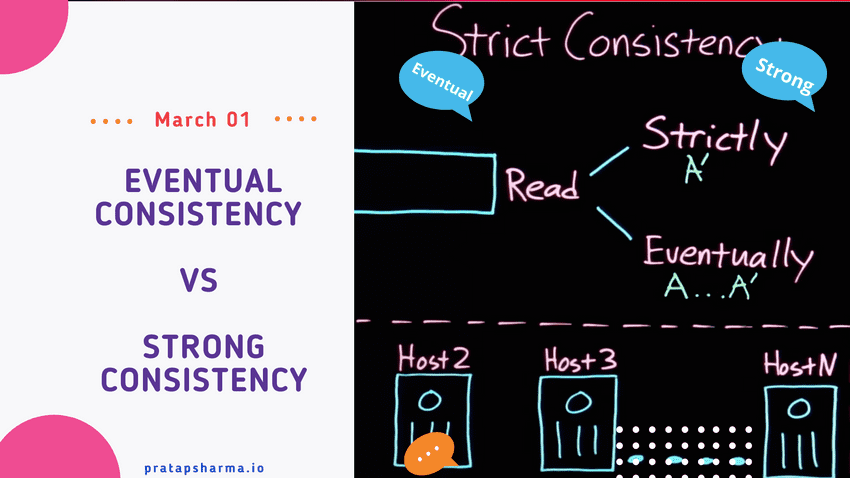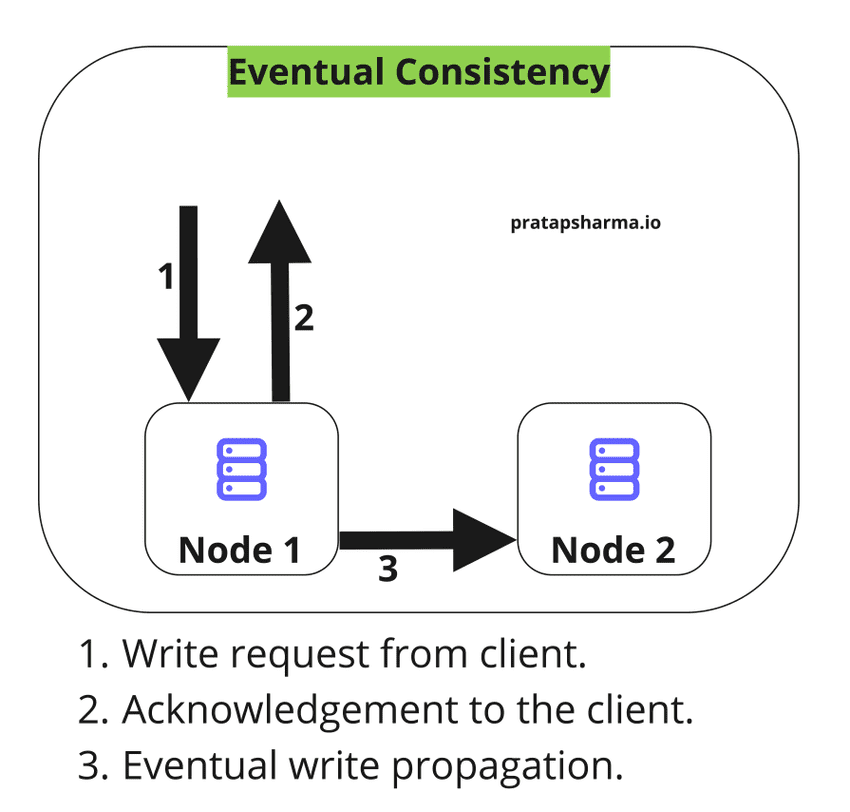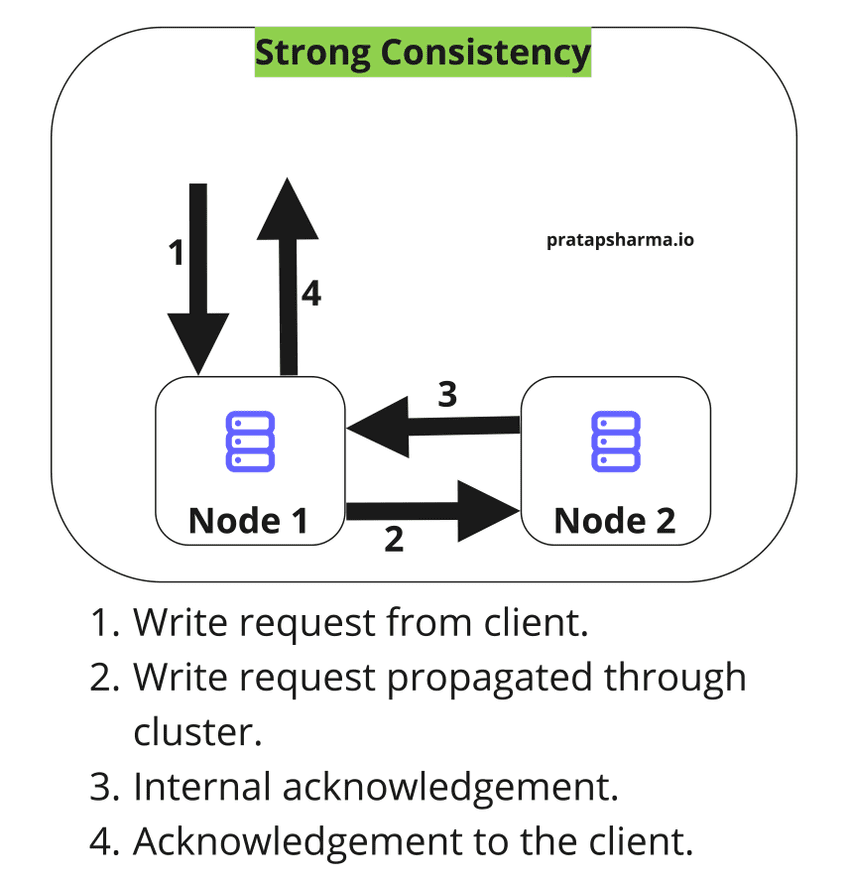Consistency is a fundamental concept in distributed systems. It refers to the property that all nodes in the system agree on the state of the system at any given time. Consistency is crucial because it ensures that the system is always in a valid state, even if there are concurrent updates or failures. There are two types of consistency models that are commonly used in distributed systems: eventual consistency and strong consistency. In this blog, we will explore the differences between these two models and when to use each one.
Eventual Consistency
Eventual consistency is a consistency model that allows for temporary inconsistencies in a distributed system. In this model, updates are made to individual nodes in the system, and these updates are propagated to other nodes over time. As a result, different nodes may have different views of the system at any given time. However, eventually, all nodes will converge to the same view of the system.
Eventual consistency is often used in systems that prioritize availability over consistency. In such systems, it is acceptable to have temporary inconsistencies as long as the system continues to function. Examples of such systems include content delivery networks (CDNs) and social media platforms. In a CDN, it is more important to deliver content quickly than to ensure that all nodes have the same view of the system at all times. Similarly, in a social media platform, it is more important to allow users to post updates quickly than to ensure that all users see the same view of the platform at all times.
Strong Consistency
Strong consistency is a consistency model that ensures that all nodes in a distributed system have the same view of the system at any given time. In this model, updates are made to multiple nodes simultaneously, and these updates are guaranteed to be consistent across all nodes. As a result, all nodes can read the most recent state of the system at any given time.
Strong consistency is often used in systems that prioritize consistency over availability. In such systems, it is important to ensure that all nodes have the same view of the system, even if it means that the system may be temporarily unavailable. Examples of such systems include financial systems, databases, and e-commerce platforms. In a financial system, it is critical to ensure that all transactions are consistent across all nodes to prevent fraud and errors. Similarly, in a database or e-commerce platform, it is important to ensure that all users have the same view of the data to prevent conflicts and errors.
Differences between Eventual and Strong Consistency
| Feature | Eventual Consistency | Strong Consistency |
|---|---|---|
| Consistency Level | Allows temporary inconsistencies | Ensures all nodes have the same view of the system at any given time |
| Trade-off | Prioritizes availability over consistency | Prioritizes consistency over availability |
| Use cases | Content delivery networks, social media platforms, messaging systems | Financial systems, databases, e-commerce platforms |
| Consistency guarantee | Weaker guarantee | Stronger guarantee |
| Update propagation | Updates are made to individual nodes and propagated over time | Updates are made to multiple nodes simultaneously |
| System state | System state is not guaranteed to be consistent at any given time | System state is guaranteed to be consistent at any given time |
| Convergence time | All nodes eventually converge to the same view of the system | All nodes have the same view of the system in real-time |
| Priority | Availability | Consistency |
| Example | Different nodes may have different views of the system at any given time | All nodes have the same view of the system at any given time |
Note: The table is a summary of the differences between eventual consistency and strong consistency based on the commonly known features of these consistency models. It is important to note that there may be exceptions or variations depending on the specific implementation or use case of these models.
When to Use Eventual Consistency
Eventual consistency is a good choice for systems that prioritize availability over consistency. It is also a good choice for systems where temporary inconsistencies are acceptable. Examples of such systems include content delivery networks, social media platforms, and messaging systems. In these systems, it is more important to deliver content quickly than to ensure that all nodes have the same view of the system at all times.
When to Use Strong Consistency
Strong consistency is a good choice for systems that prioritize consistency over availability. It is also a good choice for systems where temporary inconsistencies are not acceptable. Examples of such systems include financial systems, databases, and e-commerce platforms. In these systems, it is critical to ensure that all transactions and data are consistent across all nodes to prevent fraud, errors, and conflicts.
Conclusion
In conclusion, eventual consistency and strong consistency are two different consistency models that are commonly used in distributed systems. Eventual consistency
You may also like my other articles:
- Why is System Design Important?
- Building Real-time Applications with Redis Pub/Sub
- Understanding Proxies: The Differences Between Forward and Reverse Proxies
💌 If you'd like to receive more tutorials in your inbox, you can sign up for the newsletter here.
Please let me know if there's anything else I can add or if there's any way to improve the post. Also, leave a comment if you have any feedback or suggestions.



Discussions